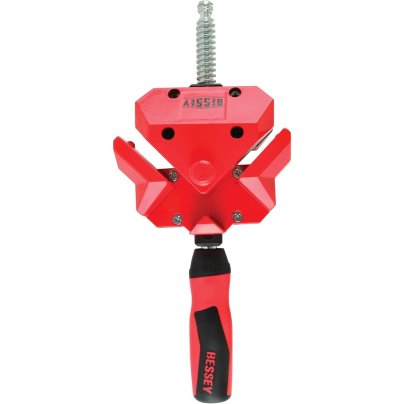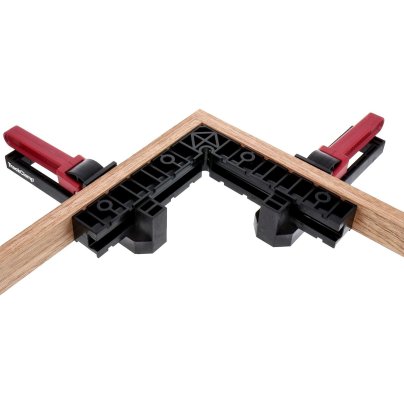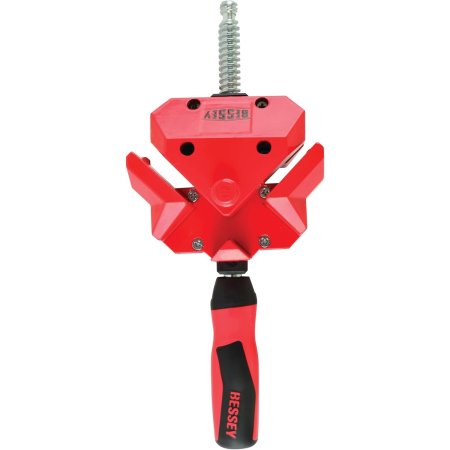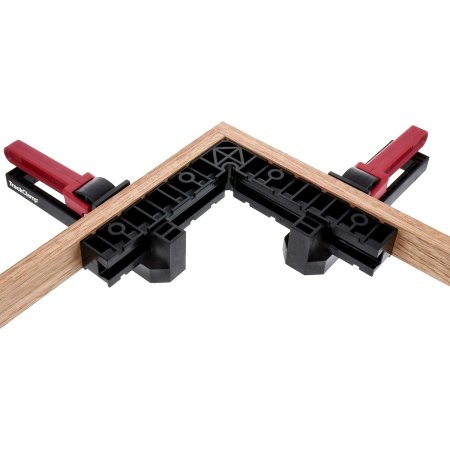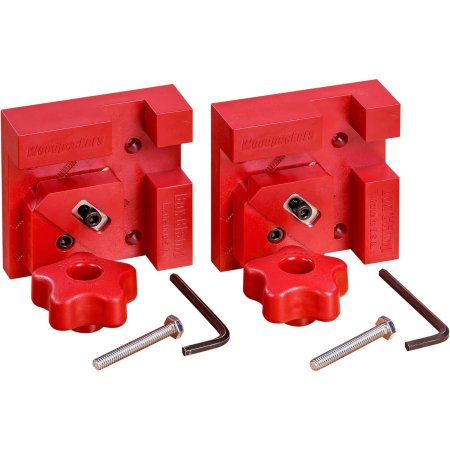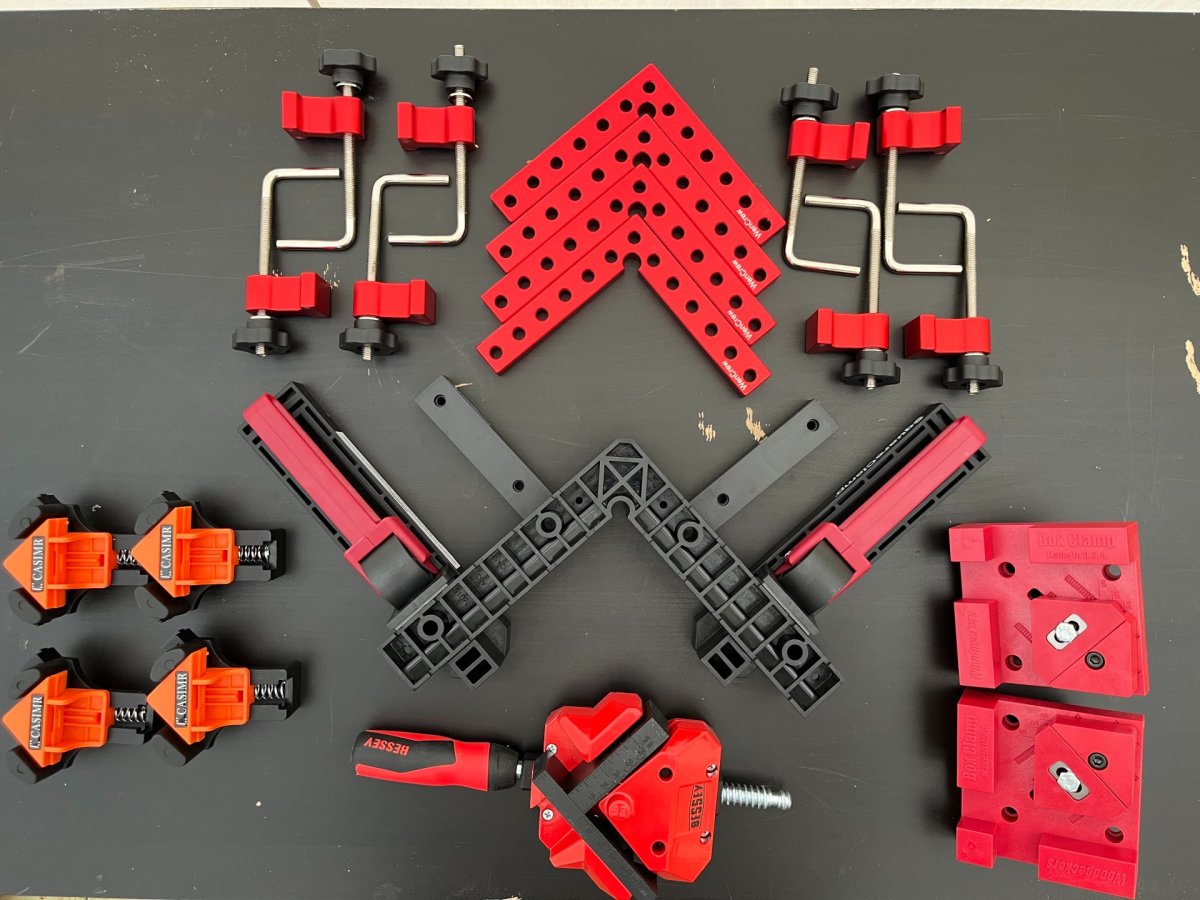
We may earn revenue from the products available on this page and participate in affiliate programs. Learn More ›
Right angle clamps are some of the most helpful woodworking tools because they do the job of that third hand that we sometimes wish we had. Most wood projects, from bird houses to picture frames, custom cabinetry and beyond have two or more parts that intersect at 90-degree angles, but holding the pieces in position by hand while gluing or fastening them together is nearly impossible. Woodworking corner clamps, or right-angle clamps, are a game changer for these projects, and there are lots of options to choose from. We tested 7 different clamps to find out which ones performed best in different project scenarios.
Overall the tools we tested proved incredibly helpful for a wide variety of corner construction projects such as mitered, dovetailed, and butt joints. Several worked best for box joints and outside corners, a few stood out for their ability to hold T-joints or frame assemblies. Our favorite, the Bessey Angle Clamp, exemplified the ease of use, durability, and versatility that woodworkers want from their essential tools. But it was a little pricey and may not be the ideal option for every project. Others we tested will be better for smaller craft projects, assembling picture frames, making boxes, and various other projects.
In this guide we review the strengths and weaknesses we observed from testing these clamps, offer a couple of recommendations for highly rated clamps that we did not test, and provide shopping considerations to help you choose the best right angle clamp for your project.
- BEST OVERALL: Bessey WS-3+2K-CB Angle Clamp
↓ Jump to Review - BEST BANG FOR THE BUCK: Casimr 90-Degree Corner Clamp
↓ Jump to Review - BEST FOR FRAMES: Milescraft Square Clamp Kit
↓ Jump to Review - BEST FOR BOXES: Woodpeckers M2 Box Clamps
↓ Jump to Review - BEST FOR WOODWORKING: WenCrew Corner Clamps
↓ Jump to Review - BEST FOR IRREGULAR SHAPES: Bessey Strap Clamp With 90-Degree Corner Pieces
↓ Jump to Review - BEST FOR T JOINTS:Kreg KHCCC 90-Degree Corner Clamp
↓ Jump to Review
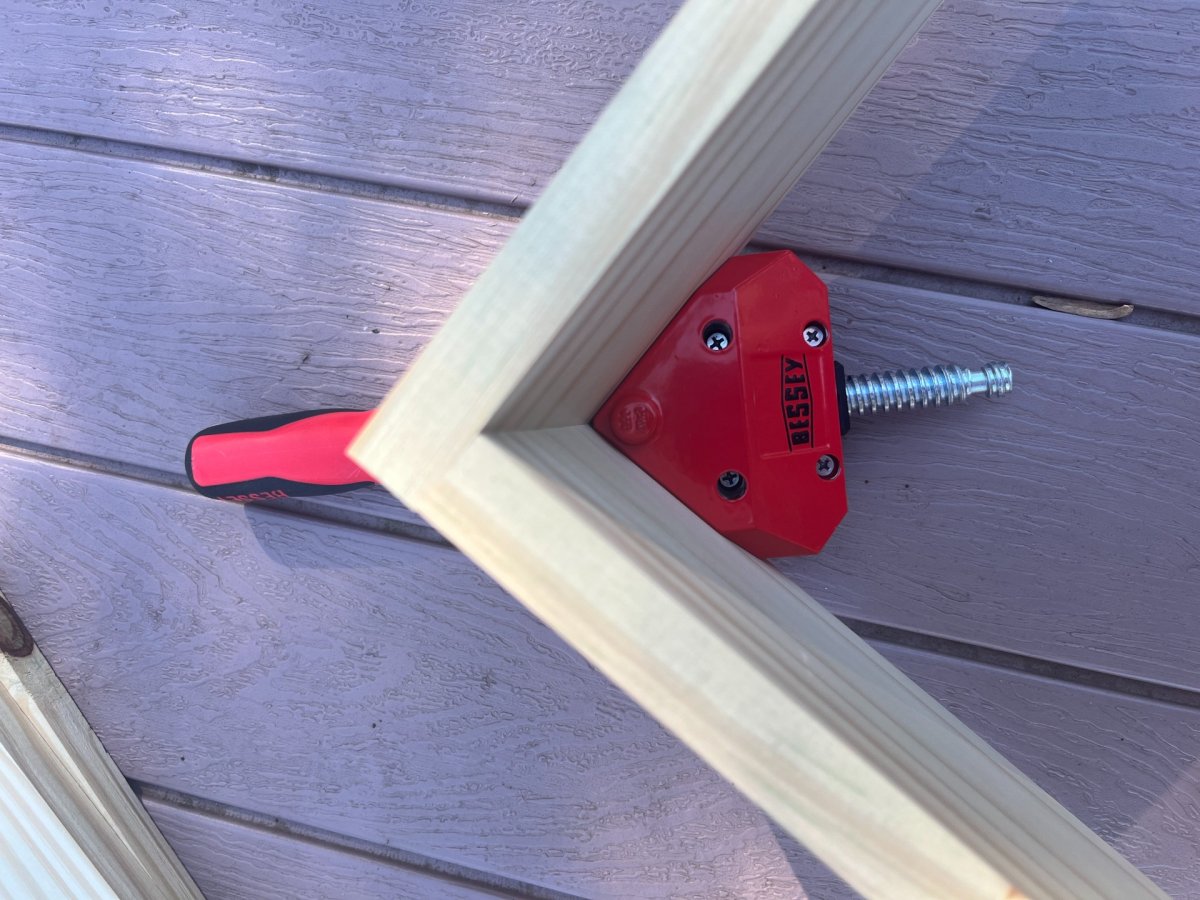
| Number of brackets | Jaw dimensions | Max material thickness | |
| Bessey WS-3+2K-CB Angle Clamp | 1 | 3 ¾ x 3 ¾ x 1 inches | 2 inches |
| Casimr 90-Degree Corner Clamp | 4 | 1 ½ x 1 ½ x 1 inches | ¾ inch |
| Milescraft Square Clamp Kit | 1 | 6 ½ x 6 ½ x 1 ¼ inches | 5 ¼ inches |
| Woodpeckers M2 Box Clamps | 2 | 4 x 4 x ¾ inches | ¾ inch |
| WenCrew Corner Clamps | 4 | 4 ¼ x 4 ¼ x ½ inches | 2 ¾ inches |
| Bessey Strap Clamp With 90-Degree Corner Pieces | 4 | 1 ¼ x 1 ¼ x 1 inches | 144 inches |
| Kreg KHCCC 90-Degree Corner Clamp | 1 | Not given | 1 inch |
Our Top Picks
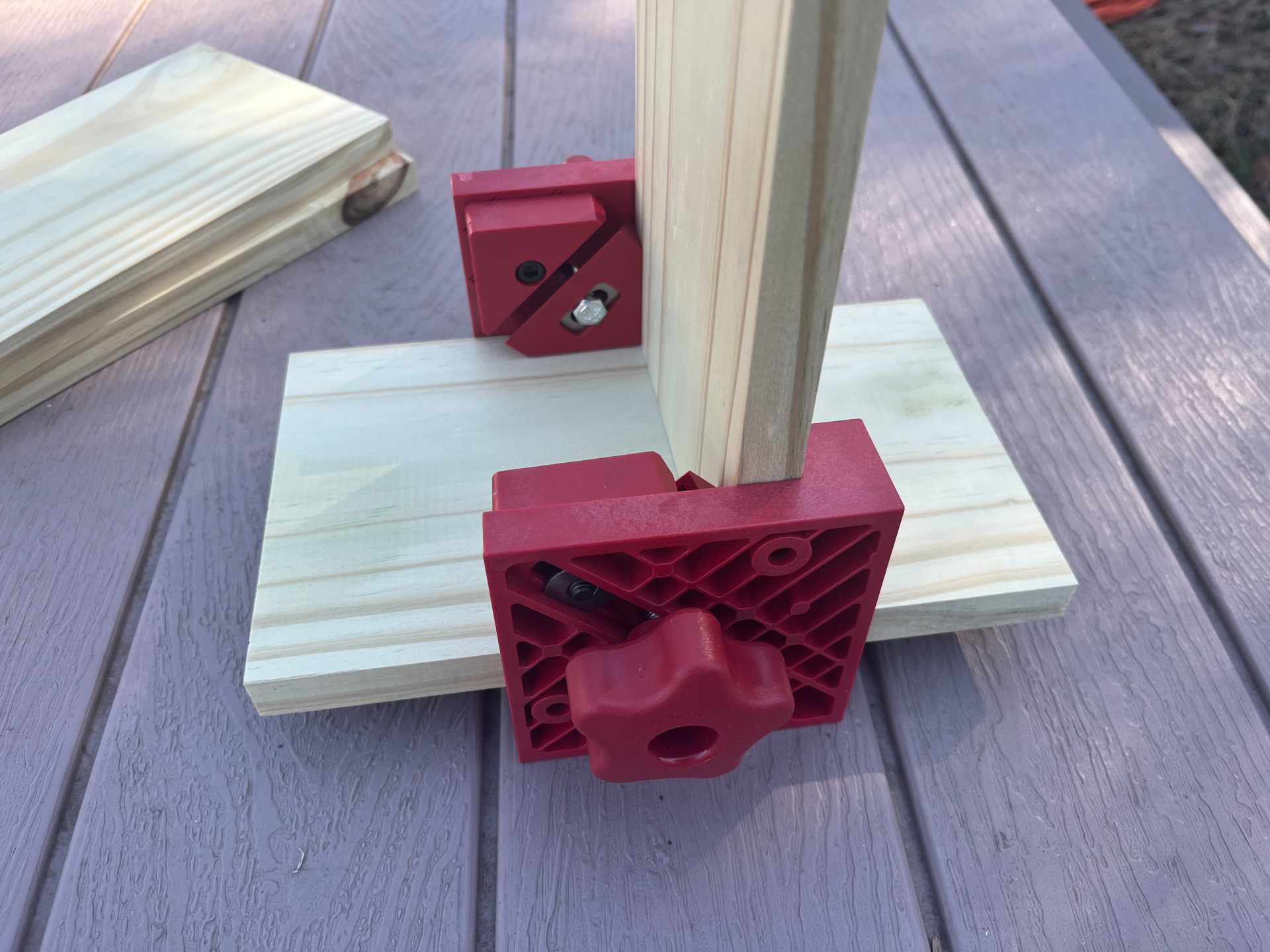
Right angle woodworking clamps come in a variety of types and sizes to help with a variety of projects. In these reviews, we provide brief product descriptions and then share our observations from testing. If you are tired of dealing with workarounds, one of these clamps could be the tool you’ve been searching for.
Best Overall
Bessey WS-3+2K-CB Angle Clamp
What We Like
- Easy to set up
- Works with numerous joint types
- Plenty of clearance to install fasteners
- Sturdy steel construction
What We Don’t Like
- More expensive than other options
- Heavier and bulkier than other options
Specs
- Number of brackets 1
- Jaw dimensions 3¾ inches long by 3¾ inches wide by 1 inch high
- Maximum material thickness 2 inches
Our Ratings: Ease of Use 5/5; Functionality 4.75/5; Durability 5/5; Accuracy 5/5; Value 4.7/5
A sturdy corner clamp makes securing boards at a precise 90-degree angle easier. The Bessey WS-3-2K-CB Angle Clamp tops our list because of its versatile design and rugged build. It features plastic coated die cast metal jaws that self-adjust within a 4-inch range to match the thickness of the boards, including two boards of different thickness. The open design allows plenty of clearance to install dowels or fasteners while gluing.
While the design of the Bessey clamp was comparable to a few others in the test group, its wider jaw capacity and heavy-duty build truly stood out. Weighing in at a hefty 2 pounds, the substantial metal jaw and stainless steel spindle should withstand a lifetime of shop use.
Best of all was the large, variable clamp capacity. This was the only “box clamp” we tested that could also accommodate mitered picture frame members up to 2 inches wide. The next largest material capacity among our tested models was only 1 inch. This Bessey can hold T joints, and we liked how easily the clamp accommodated unequal thicknesses. There was no need to manually adjust anything—simply line up the corner and twist the handle. It just works.
What our tester says: “The Bessey Angle Clamp directed pressure in just the right places. It was simple to set up, delivered good pressure for glue-set, and held perfect alignment while I installed nails and pocket hole screws. For time savings on most real world projects I would want at least two of these.” —Mark Wolfe, Product Reviews tester and writer
Get the Bessey right angle clamp at Amazon, The Home Depot, Ace Hardware, Woodcraft, or Rockler.
Best Bang For The Buck
Casimr 90-Degree Corner Clamp
What We Like
- Budget-friendly price
- Easy to use spring-clamp mechanism
- Can be used with boards of unequal thickness
- Great for thin box frames
What We Don’t Like
- Does not work with T joints
- Precise alignment requires some fine adjustment
Specs
- Number of brackets 4
- Jaw dimensions 1½ inches long by 1½ inches wide by 1 inch high
- Maximum material thickness: ¾ inch
Our Ratings: Ease of Use 5/5; Functionality 4.5/5; Durability 4/5; Accuracy 4/5; Value 5/5
For many projects, there is no need to spend a fortune on expensive clamps. These Casmir spring-loaded right angle clamps are lightweight, fast, easy to use, and very affordable. Plus, this set of four allows users to clamp all four corners of an assembly at the same time.
These lightweight corner clamps for wood are ideal for small projects made with thin material. The jaw capacity is supposed to be ¾ inch, but working with material of that size proved challenging due to lack of clearance. We had to be very careful to maintain alignment and avoid marring the surface of the wood. They worked much better with slightly thinner boards.
The spring closure worked well. We really liked the ability to install the clamp with one hand while maintaining project alignment with the other. Again, smaller projects are the key. We do not recommend using these for cabinet frame construction, although they could work with some patience. The open sides made it easy to install hardware after clamping right angles, and the springs had plenty of tension to hold everything together as we did so.
Get the Casmir right angle clamps at Amazon.
Best For Frames
Milescraft Square Clamp Kit
What We Like
- Clamps to the inside or outside of the joint
- Accepts a wide range of material thicknesses
- Plenty of jaw depth for wide frame material
- Includes workpiece supports
What We Don’t Like
- Best used on a horizontal work surface
Specs
- Number of brackets 1
- Jaw dimensions 6½ inches long by 6½ inches wide by 1¼ inches high
- Maximum material thickness: 5¼ inches
Our Ratings: Ease of Use 5/5; Functionality 4.75/5; Durability 5/5; Accuracy 5/5; Value 4.7/5
A deeper bracket usually works best when clamping the mitered corners of a picture frame. The MilesCraft Square Clamp Kit features an 8-inch L bracket with a 6½-inch jaw length, and adjustable cam clamps that accept boards up to 5¼ inches wide. For added convenience, the kit comes with two material supports to hold the project pieces level to prevent racking, and rubber clamp pads prevent damaging the wood surface.
The MilesCraft Square Clamp Kit worked well as a box clamp, but truly excelled as a frame clamp. The L bracket offers two placement holes along each of the arms that mate with molded pegs on the clamps. After choosing the best clamp position, adjusting the cams to match the width of the frame boards was a simple matter of sliding the locking levers toward or away from the bracket. The system is bulkier than the others we tested, which might be a storage consideration for smaller shops, but it was very easy to use and very effective when clamping picture frame members.
What our tester says: “The MilesCraft clamping kit serves a variety of functions really well, particularly if you mix and match components. I swapped the included cam clamps for F clamps for box framing. But the adjustable cam clamps, serving the added role of material support, were the key feature that made this system perfect for frame construction.” —Mark Wolfe, Product Reviews tester and writer
Get the MilesCraft right angle clamp at Amazon, The Home Depot, or MilesCraft.
Best For Boxes
Woodpeckers M2 Box Clamps
What We Like
- Unique design helps align the corner joint
- Works with corners and T joints
- Can be used on a tabletop or applied freehand
- Allows easy access for fastener installation
What We Don’t Like
- More expensive than most other options
Specs
- Number of brackets 2
- Jaw dimensions 4 inches long by 4 inches wide by ¾ inches high
- Maximum material thickness 1 inch
Our Ratings: Ease of Use 5/5; Functionality 4.75/5; Durability 4/5; Accuracy 5/5; Value 4/5
A traditional assembly method for deep box corners uses matched clamps at the top and bottom of the corner to keep the parts aligned. We really liked the Woodpeckers M2 box clamps because of their strong, low-profile design and easy setup. The clamps can be attached to a workbench through the built in screw holes, or applied freehand with the included thumb screw spindle. The design works with both outside corners and T-joints and accommodates workpieces of varying thicknesses. The snug grip prevents movement during glue ups and fastener installation.
These clamps proved versatile during our tests. Because they can handle both corners and T joints, they did a great job with alignment, including cabinet and drawer box assembly, especially with 90 degree joints that were more than 10 inches long. The molded plastic clamp faces included a scale that helped to ensure perfect positioning at both ends of long corners, whether assembled vertically or horizontally.
The most helpful aspect of these clamps was that they ensured precise alignment. They do not apply strong pressure on the joint. Where a tight squeeze is required, we recommend using these for assembly and then adding a strap clamp or bar clamps to apply pressure on the joint(s). The price was a bit higher than we would have preferred, but they worked perfectly.
Get the Woodpeckers right angle clamp at Amazon, ToolNut, Tools Today, or Woodpeckers (set of 2).
Best For Woodworking
WenCrew Corner Clamps
What We Like
- Set includes 4 square brackets and 8 clamps
- Durable aluminum and steel construction
- Works inside or outside the joint
- Adjustable clamping length and depth
What We Don’t Like
- Not as quick and easy to assemble as squeeze clamps
Specs
- Number of brackets 4
- Jaw dimensions 4¼ inches long by 4¼ inches wide by ½ inch high
- Maximum material thickness: 2 ¾ inches
Our Ratings: Ease of Use 4/5; Functionality 4.75/5; Durability 5/5; Accuracy 4/5; Value 4.7/5
A woodworker can never have too many clamps, especially when it comes to precise right angle assemblies. These aluminum positioning squares from WenCrew make it easy to quickly align parts for gluing or installing fasteners. The kit includes four aluminum brackets and eight aluminum and threaded steel clamps.
We used the WenCrew corner clamps to position mitered and square cut corner pieces. As with other positioning clamps, they did a really good job holding the parts at the proper angle, but are not intended to apply pressure on the joint. The clamps accommodated a variety of materials ranging from ⅜-inch plywood to 2×4 lumber.
The WenCrew clamps were much more affordable than the nearly identical brand name version, and offered good versatility whether we needed to mate materials of different thicknesses or to position them on the inside or outside of the corner. The only awkward part was dealing with the aluminum clamp foot at the base of the knob. Because it spins freely on the spindle, it sometimes fell out of position before we could get the knob tight. That was a minor and occasional inconvenience from an otherwise excellent tool.
Get the WenCrew right angle clamps at Amazon.
More Great Options
With so many different right angle clamp types and styles to pick from, we could not test them all. In this section we highlight highly rated right angle clamps that fit differently from the ones we tested. If the previous products are not quite right for your woodworking project, one of these handy corner clamps for woodworking might do the trick.
Best Strap Clamp
Bessey Strap Clamp With 90-Degree Corner Pieces
What We Like
- Full assembly clamp for larger workpieces
- Fits squares and rectangles up to a 144-inch perimeter
- Strap places even pressure in both directions
- Applies adequate mating pressure for glue joints
What We Don’t Like
- Careful setup required to maintain corner bracket positions
Specs
- Number of brackets 4
- Jaw dimensions 1¼ inches long by 1¼ inches wide by 1 inch high
- Maximum material thickness 144 inches
Many right angle clamps are designed for alignment purposes but they do not apply gripping pressure required for seamless joinery. The Bessey Strap Clamp answers the call by applying firm, even, inward pressure to close the gaps for tight setting glue-ups. It comes equipped with a 12-foot strap and four right angle corner braces. Place the strap around the workpiece, position the corner braces while pulling out the slack, then twist the handle to increase clamping pressure.
This clamp is designed to apply inward pressure, so some alignment adjustments may be necessary while increasing clamp pressure. For larger projects, it may be helpful to use additional types of clamps for accurate positioning. Bessey Strap Clamps may be used alone or in combination with other clamps, as project needs dictate.
Get the Bessey right angle strap clamp at The Home Depot, Ace Hardware, or Menards.
Best For T Joints
Kreg KHCCC 90-Degree Corner Clamp
What We Like
- Durable cast aluminum V- and wedge-clamp pads
- One-handed setup for quick installation
- Automatically adjusts positioning to fit up to 1-inch board thickness
- Clamp pads have side cutouts for easy pocket screw installation
What We Don’t Like
- The most expensive clamp in this guide
- May not apply enough pressure for some applications
Specs
- Number of brackets 1
- Jaw dimensions not provided
- Maximum material thickness: 1 inch
Cabinets, shelving, and other frame projects often require one or more T joint locations, but not all right angle clamps can do the job. The Kreg KHCCC 90 Degree Corner Clamp is designed to take on both end corners and T joints made with material up to 1 inch thick. One of the more expensive options in this lineup, the value comes from its durable build with cast aluminum clamp pad and wedge, and fast, one-handed operating convenience.
The key to the automatic thickness adjustment is the pivoting wedge. It automatically puts pressure in the precise direction. The handle works similarly to locking pliers so that the clamp can be applied with one hand, leaving the other hand free to better control the workpiece. This is one of the best pocket hole clamps for assembling butt joints that will be joined with pocket hole screws. It holds the correct angle securely, and even includes pocket hole access points at the edges of the clamp pad.
Get the Kreg right angle clamp at Amazon, The Home Depot, Woodcraft, or Menards.
Jump to Our Top Picks
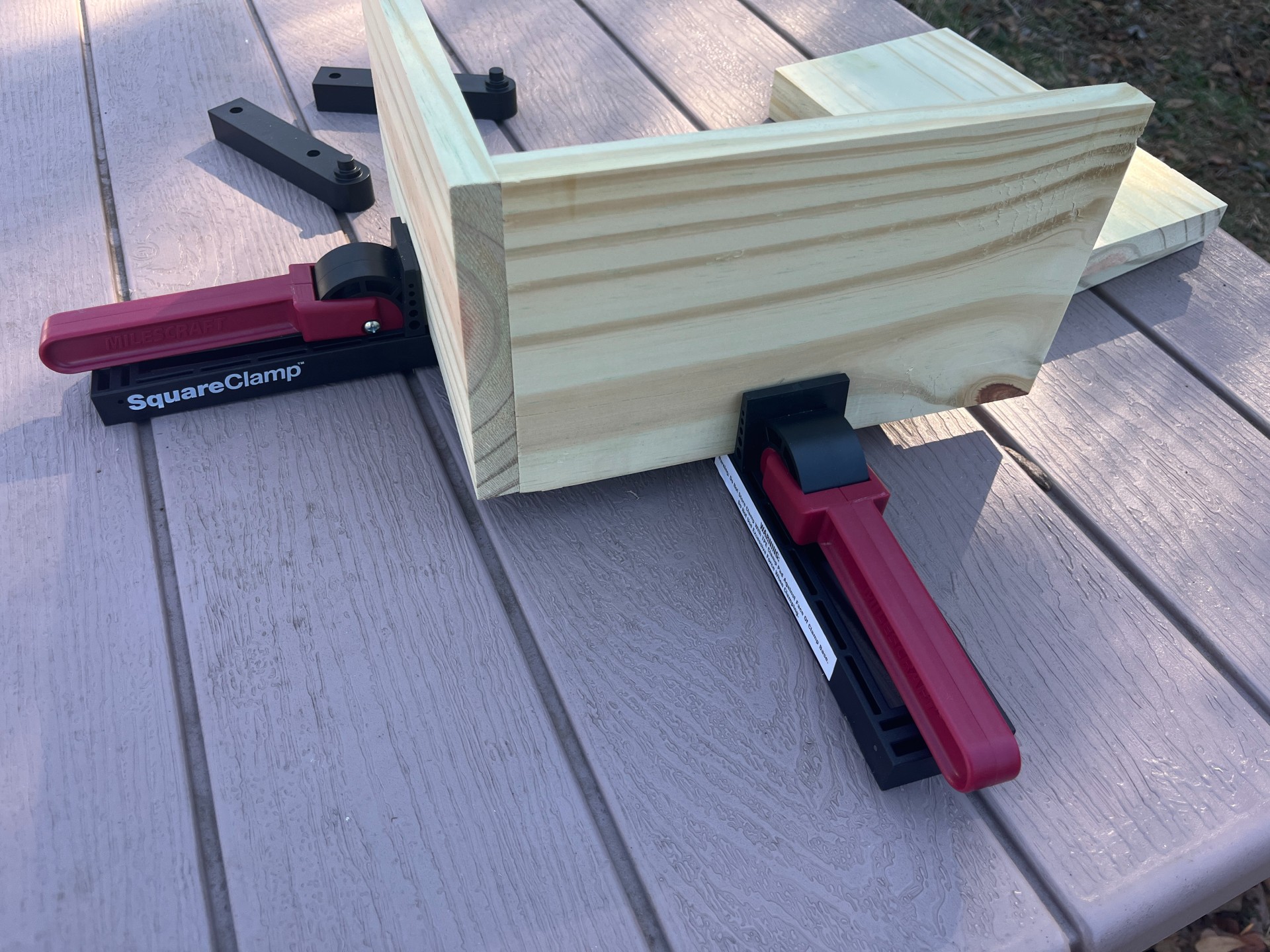
How We Chose and Tested the Best Right Angle Clamp
| Products tested | 5 |
| Time spent testing | 15 hours |
| Tests performed | 9 |
| Price range | $10 to $50 |
We researched highly rated right angle clamps and discovered that the most effective models are affordable, easy to use, versatile, durable, and accurate. For testing, we chose clamps made of materials that could withstand light- to heavy-duty clamping pressure, including aluminum alloy, steel, carbon steel, and ABS plastic. We included a range of options that could accommodate various wood dimensions, with some options being able to hold materials up to 5 inches wide. We tested our top five picks by using them to construct different joints, including glued-together mitered and dovetail corners, and butt joints fastened with pocket hole screws and nails. After testing, we recorded our observations on a scoring rubric before awarding the category winners.
| Ease of Use | Functionality | Durability | Accuracy | Value | |
| Bessey WS-3+2K-CB Angle Clamp | 5 | 4.75 | 5 | 5 | 4.7 |
| Casimr 90-Degree Corner Clamp | 5 | 4.5 | 4 | 4 | 5 |
| Milescraft Square Clamp Kit | 5 | 4.75 | 5 | 5 | 4.7 |
| Woodpeckers M2 Box Clamps | 5 | 4.75 | 4 | 5 | 4 |
| WenCrew Corner Clamps | 4 | 4.75 | 5 | 4 | 4.7 |
What to Consider When Choosing a Right Angle Clamp
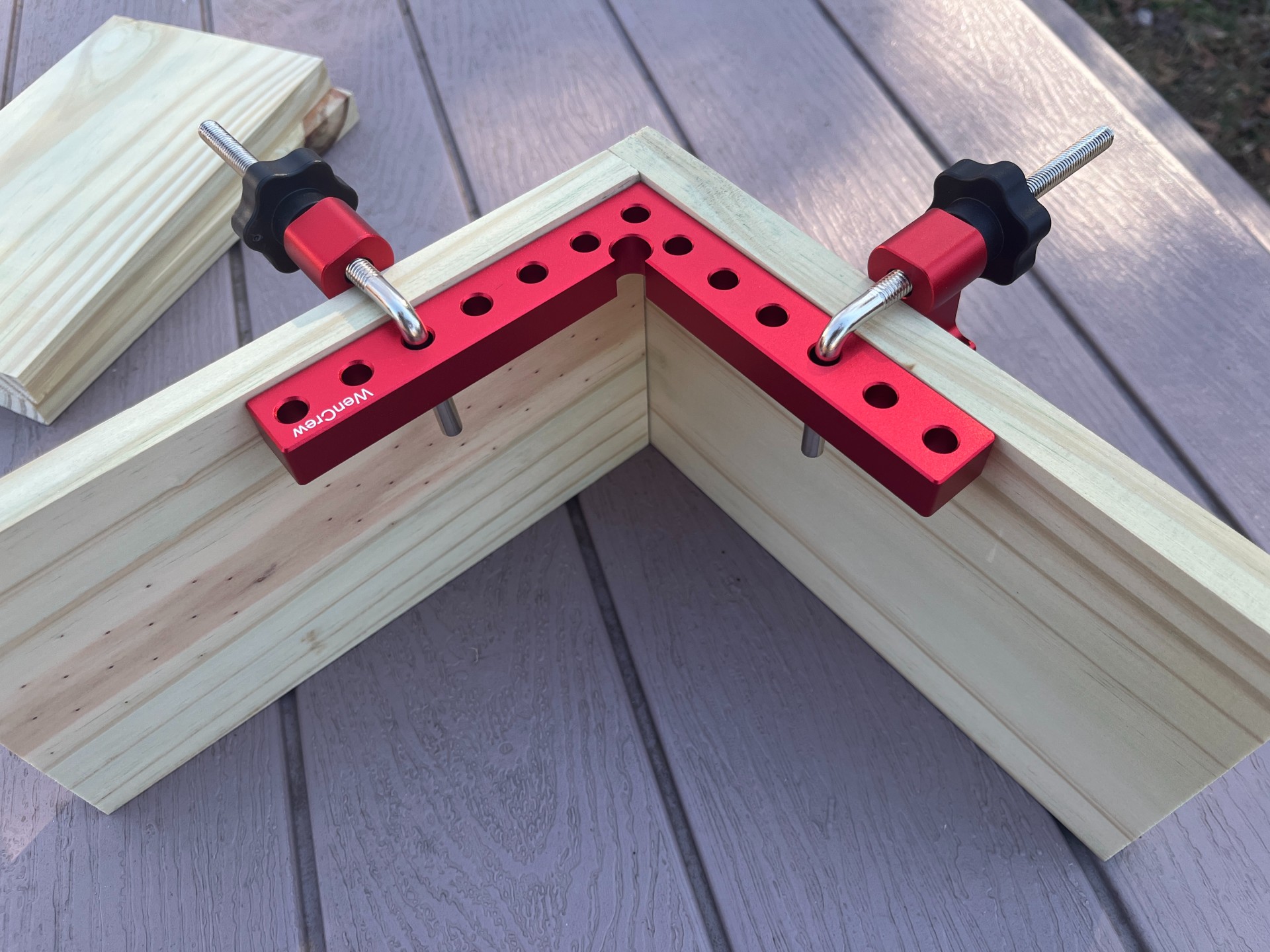
Joining wood, metal, or any other material at a right angle can be a clumsy process. A 90-degree angle clamp can make the entire ordeal easier, but only if you buy the right one. To determine which of these clamps is best for your workshop, it’s prudent to consider factors like durability, accuracy, and clamping range.
Material
As with all woodworking tools, a right angle clamp’s construction is the key to its performance. Lightweight clamps are made out of thinner aluminum or even plastic, meaning they’ll work well for light-duty jobs such as picture frame building, but they won’t hold up to clamping right angles on heavier materials for projects like cabinet building or metal welding. For heavy-duty tasks, look for clamps with reinforced aluminum bodies and steel spindles and arbors.
Accuracy
Accuracy and material type go hand in hand. Durable aluminum alloy and steel clamps won’t warp or bend under pressure, which allows for a perfect 90-degree angle. Single-handle clamps also offer a high degree of accuracy, as they enable users to clamp both pieces simultaneously via a single handle, once aligned.
Clamping Range
A right angle clamp isn’t suitable if it can’t hold the materials to be clamped together. Make sure to check how wide the clamp’s jaws can open to determine if it offers a wide enough range to hold the selected materials. Most clamps can hold materials as wide as 2 to 2¾ inches). All clamps on our list can join materials of two different widths.
Capacity
The clamp’s capacity incorporates both its range, described above, and the jaw’s width and depth. Most clamps have a jaw width between 3½ and 4 inches and a jaw depth between 1 and 1½ inches. A clamp with a wide and deep jaw has more surface area to clamp the materials being joined.
The greater the jaw’s width, the more stable the clamp can be holding longer and heavier materials in place. While a smaller angle clamp may suffice for a picture frame project, an angle clamp with a longer jaw is necessary for projects involving larger pieces, such as cabinetmaking.
Spindle
The spindle is the long nut attached to the handle that threads through the arbor and into a bolt. The handle turns the spindle, which tightens the clamp. Given that it’s responsible for holding the material in place, it’s the critical component in a right-angle clamp. Most spindles are made out of aluminum. Heavy-duty clamps feature heat-treated spindles with steel nuts, which are harder and thus more durable than standard steel. Heat-treated spindles, like those used on welding clamps, are less likely to bend or strip under the pressure of clamping larger materials.
Handle
Given how tricky the process is to align two pieces of wood, metal, or glass into the clamp, the handle is an integral part of a right angle clamp. In most cases, users will want to operate the handle with one hand while using the other to steady the two pieces they’re clamping together. For ease of use, most right angle clamps work with a single handle that clamps both parts simultaneously. The handle should be large enough to tighten easily with one hand.
Padding
Getting a good grip on the handle while holding everything in place is crucial. With that in mind, most handles feature padded nonslip grips that are easy to hold while tightening the clamp.
Setup
It used to be that right angle clamps featured multiple handles and jaws that required more aligning and turning. Innovations in right angle clamps have made setup much more manageable. Clamps designed with single handles operate one L-shaped jaw that can clamp both pieces at the same time. These clamps can also pivot on the spindle to accommodate pieces with two different widths. And if that doesn’t offer enough ease, most angle clamps feature holes in the base that allow them to be mounted to a workbench to add more stability for setup.
FAQs
Whether you’re wondering how to clamp a corner or need more guidance about the different types of clamps, read on for answers to some of the most commonly asked questions.
Place the clamp face up on a flat surface, making sure there’s enough space for the two pieces you plan to join and that the clamp’s jaws are open. Slide the first piece into the clamp, lining the end up with the corner of the clamp’s arbor. Slide in the second piece until it meets with the first piece. Align the two parts until the ends are flush to each other with no overhanging edges. Hold the pieces in place with one hand while tightening the clamp with the other. Tighten by turning the handle clockwise until firm. Avoid over-tightening, which may damage the material.
Irregularly shaped materials will not fit flush to the clamp’s flat jaws, preventing it from adequately holding the piece. To fix this problem, you’ll want to create a brace out of scrap wood that fits between the clamp jaws and the material. The brace, which can be a single piece or multiple pieces, includes a flat side that fits flush to the jaws and an irregular side that fits flush to the piece. The brace allows the clamp to grip firmly by filling the gaps between the jaws and the irregularly shaped piece.
There are a couple of ways to do this. One method is to use a miter saw to create a miter joint. Cut each end to be joined at a 45-degree angle using a miter saw. Apply glue to the ends of the pieces. Using the right angle clamp, clamp the pieces so the mitered ends butt together, creating a mitered joint. Allow the glue to dry, then use nails or screws to reinforce the joint. If using screws, drill a pilot hole for each screw to prevent the wood from splitting.
You can also join the two pieces using a basic butt joint. Simply place the end of one board against the side of the end of the other in the angle vice, making sure the ends are flush. As with a miter cut, use glue to join and reinforce with nails or screws once dry.
G and F clamps are often used to attach right angle brackets. G clamps have a fixed throat depth, while F clamps have a sliding jaw to accommodate a wider range of material sizes.
If you are buying a clamp for a single project, the thickness of the wood and the dimensions of the corner should guide your clamp purchase.
Right angle clamps will be positioned in one of two configurations, depending on the clamp type. Those with L brackets will have a clamp on each arm of the L shape. Box clamps, on the other hand, typically have a single clamp that directs pressure toward the intersection of the two sides.
Whether you’re talking about parallel clamps or pocket hole camps, there is no single best material for these tools. Steel is a durable and dependable material for threaded components, jaws, and springs. Rubber, plastics, and other synthetic materials work well for clamp pads, handles, and other components.
Meet the Tester
Mark Wolfe is a writer, product tester and serial DIYer who lives in an older home. When he isn’t writing, he spends his time upgrading, repairing, and replacing anything and everything in his home, yard, and garden. He tests and writes reviews about hand and power tools, lawn care and home repair products, and outdoor living goods.
Additional research provided by Tony Carrick.
